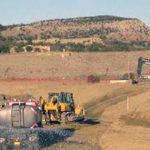- The co-applicants filed a water court request to add instream flow use to the Shoshone rights.
- Lawmakers and state leaders praised the Colorado Water Conservation Board vote.
- The proposed change would preserve historic operations at the Shoshone Hydropower Plant.
- The agreement represents decades of statewide collaboration.
- Several major approvals and full financing are still required.
Tuesday, November 25, 2025 — On November 20, the Colorado River District, the Colorado Water Conservation Board, and the Public Service Company of Colorado jointly filed a change of water rights application in Division 5 Water Court . The filing seeks to authorize instream flow use for the historic Shoshone Water Rights while preserving continued hydropower production at the Shoshone Hydropower Plant in Glenwood Canyon.
. The filing seeks to authorize instream flow use for the historic Shoshone Water Rights while preserving continued hydropower production at the Shoshone Hydropower Plant in Glenwood Canyon.
The water court process will determine whether the proposed change protects other decreed water rights. The applicants stated that they intend to keep the historical operation of the Shoshone Water Rights in place, including the longstanding pattern of non-consumptive use and return flows that stabilize the upper Colorado River.
The filing follows the Colorado Water Conservation Board’s unanimous November 19 vote to accept a perpetual interest in the Shoshone Water Rights for instream flow use and to sign an instream flow agreement with the Colorado River District and the Public Service Company of Colorado. The vote marked the final administrative step required before the matter could enter water court.
Broad Public Support and Statewide Significance.
The Colorado Water Conservation Board’s action drew widespread attention. Governor Jared Polis released a statement on November 20 praising the decision, noting that “thousands of Coloradans, our fish, and our wildlife depend on this water every day.” He said the acquisition will support hydropower, agriculture, recreation, and environmental protection while giving western slope communities greater long-term certainty.
Colorado’s Western Slope congressional delegation echoed the sentiment. Representatives Joe Neguse and Jeff Hurd issued a joint statement commending the board’s vote and reaffirming their support for delivering the remaining $40 million allocated at the federal level for the project.
commending the board’s vote and reaffirming their support for delivering the remaining $40 million allocated at the federal level for the project.
Public interest has been high throughout the process. Thirty-five local governments, water providers, and non-profit groups filed in favor of converting the Shoshone rights to a permanent instream flow. More than four hundred public comments also supported long-term flow protection for the upper Colorado River.
Andy Mueller, General Manager of the Colorado River District, described the board’s action as a legacy decision for Colorado and the western slope. Leaders from state and local government, including Senator Marc Catlin, Senator Dylan Roberts, and Mesa County Commissioner Bobbie Daniel, emphasized the importance of the Shoshone flows to agriculture, recreation, local economies, and downstream water security for the forty million people who rely on the Colorado River.
Understanding the Shoshone Water Rights.
The Shoshone Water Rights originate from the Shoshone Hydropower Plant, which holds a senior 1902 non-consumptive right and a junior 1929 right. These rights have long played an essential role in maintaining stable river flows by keeping water in the channel until it reaches the Shoshone diversion in Glenwood Canyon. Because they are non-consumptive, the water continues downstream after passing through the hydropower facility.
In December 2023, the Colorado River District and the Public Service Company of Colorado signed a $99 million Purchase and Sale Agreement to acquire the rights and convert them to permanent instream flow use. The effort reflects decades of work by the Shoshone Water Right Preservation Coalition.
To close the transaction, four conditions must be met:
-
An instream flow agreement with the Colorado Water Conservation Board.
-
A water court decree authorizing the change to instream flow use.
-
Full financing for the ninety-nine million dollar purchase.
-
Approval from the Colorado Public Utilities Commission.
The first condition became official with the November 19 vote.
More than $57 million has already been committed by Western Slope entities, the State of Colorado, and the Colorado River District’s Community Funding Partnership. The Bureau of Reclamation awarded an additional forty million dollars in early 2025, though those funds remain under federal administrative review.
Xcel Energy, the parent company of the Public Service Company of Colorado, stated that converting the Shoshone rights to instream flow use supports reliable hydropower generation and responsible stewardship of the river.
What Happens Next.
The co-applicants will now work through the water court review, which is required for all changes to decreed water rights in Colorado. The process will examine whether the instream flow use can occur without harming other water rights holders and whether historical operations will remain intact.
If the water court approves the change and the remaining conditions are met, the Shoshone Water Rights would become the largest environmental water right in Colorado’s history. The conversion would create a permanent mechanism to maintain flows that support agriculture, fisheries, recreation, hydropower, and ecological functions on the upper Colorado River.
Based on the steps now underway, the Shoshone protection effort is expected to play a central role in Colorado’s long-term water security strategy.
Frequently Asked Questions
What are the Shoshone Water Rights?
They are non-consumptive hydroelectric rights dating to 1902 and 1929. They keep water in the Colorado River channel until it reaches the Shoshone Hydropower Plant in Glenwood Canyon.
Why are these rights important?
Because the rights are senior and non-consumptive, they help stabilize flows on the upper Colorado River, which benefits agriculture, recreation, fisheries, hydropower, and downstream users across the Colorado River Basin.
What is an instream flow right?
It is a water right held for the purpose of maintaining water in a river channel to support the natural environment, including fish and wildlife habitat. In Colorado, instream flow rights are held by the Colorado Water Conservation Board.
What did the Colorado Water Conservation Board vote on November 19?
The board voted unanimously to accept a perpetual interest in the Shoshone Water Rights for instream flow use and to sign an instream flow agreement with the Colorado River District and the Public Service Company of Colorado.
What approvals are still needed before the transaction can close?
A water court decree, confirmation of full project financing, and approval from the Colorado Public Utilities Commission.
How much does the acquisition cost?
The Purchase and Sale Agreement signed in December 2023 set the price at ninety-nine million dollars.
Will the Shoshone Hydropower Plant continue operating?
Yes. The proposed change preserves the ability of the Public Service Company of Colorado to continue generating hydropower while adding instream flow use.
How soon could the transition be completed?
The timeline depends on the water court process and the remaining financing and regulatory approvals.





